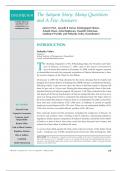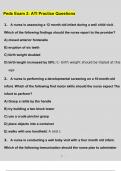COLLOQUIUM The Satyam Story: Many Questions
includes debate by and A Few Answers
practitioners and
academicians on a
contemporary topic James E Post, Jayanth R Varma, Krishnagopal Menon,
Ashank Desai, Achal Raghavan, Vasanthi Srinivasan,
Sandeep P Parekh, and Neharika Vohra (Coordinator)
INTRODUCTION
Neharika Vohra
Professor
Indian Institute of Management, Ahmedabad
e-mail: neharika@iimahd.ernet.in
T
he shocking resignation of Mr. B Ramalinga Raju, the Founder and Chair-
man of Satyam, on January 7, 2009, came as the climax of twenty-two
days of drama that started on December 16, 2008, with the negative reaction
of shareholders towards the proposed acquisition of Maytas Infrastructure (a fam-
ily-owned company of Mr. Raju) for $1.6 billion.
On January 2, 2009, Mr. Raju disclosed to the stock exchange that his family had
pledged all its shares held in its holding firm, SRSR Limited, to institutional lenders,
following which, in the next two days, the share of the Raju family in Satyam fell
from 8.6 per cent to 3.6 per cent. During the intervening period, three of the inde-
pendent Directors at Satyam resigned. On January 7, Mr. Raju confessed to his crime
and absolved all the top functionaries of Satyam stating that they had no clue as to
what was being done by him to orchestrate the elaborate fraud. Mr. Raju’s letter to
the board stated that Satyam’s balance sheet as on September 30, 2008, carried ficti-
tious cash and a bank balance of Rs. 5,040 crore. In addition, it carried an equally
KEY WORDS made-up accrued interest of Rs. 376 crore. There was an understated liability of Rs.
1,230 crore and an over-stated debtors’ position of Rs. 490 crore.
Financial Fraud
Corporate Governance This corporate drama left the spectators, including the employees of Satyam, its
investors and auditors, those working in the IT industry, outsourcing industries,
Corporate Social
regulators, Indian citizens, competitors of Indian IT industry, and all the well-wishers
Responsibility
of India in a state of shock. Since then, much has been discussed and written, and
Business Ethics actions have been taken to address the issue.
Code of Ethical Conduct
A case has been filed against Mr. Raju under relevant sections of the Indian Penal
Regulatory Reforms Code— conspiracy (sec. 120-B), criminal breach of trust (sec. 406), cheating (sec. 420),
Role of Auditors
DISCLAIMER: This Colloquium is based on information available at this time in the public domain pertain-
Leadership ing to the Satyam case. It is intended to serve as an analytical framework for understanding the issues in-
volved. It is not intended to portray the actions of any individual or individuals as right or wrong in the legal,
Global Outsourcing business or any other sense.
VIKALPA • VOLUME 34 • NO 1 • JANUARY - MARCH 2009 69
,forgery for cheating (sec. 468), and fraudulent cancella- plans for austerity measures and asking all of them to
tion of securities (sec. 477-a). The CBI has taken over the help in reducing the operational expenses wherever and
investigation and a multi-disciplinary investigation team whenever possible to get Satyam back on track. On Janu-
has been formed. Mr. Ramalinga Raju, Mr. Rama Raju ary 22, 2009, Kiran Karnik made an announcement about
(brother of Mr. Ramalinga Raju), and the CFO of Satyam, the decision of two of reasonably large customers who
Mr. Vadalmani Srinivas, continue to be behind bars. On had given notice and were leaving1 while also inform-
January 26, 2009, it was reported that five boxes of origi- ing that some new clients had joined. On the brighter
nal land documents of as many as 147 firms floated by side, the World Bank publicly announced that with the
the relatives of B Ramalinga Raju, were seized by the management having changed hands, they were open to
Andhra Pradesh police. Allegedly, these papers had been lifting their eight-year old ban imposed in December,
concealed with the knowledge of family members and 2008,on using Satyam as a vendor.
the senior trusted advisors of Mr. Raju.
Two law firms of the United Sates, Izard Nobel LLP and
On January 25, 2009, the two senior partners at Vianale & Vianale LLP, have filed class action lawsuit
PricewaterhouseCoopers (PwC), Mr. Talluri Srinivas and in the US Courts against Satyam and its board members
Mr. S Gopalakrishnan, were questioned and were taken on behalf of the owners of the American Depository
into custody for criminal conspiracy and cheating. This Receipts (ADRs) of Satyam between January 6, 2004 and
was the first time in the history of January 6, 2009. Questions have been
corporate India that Chartered Ac- raised about the credibility of Indian
countants had been held on account The unfolding of Mr. service sector, the strength of Indian
of flawed auditing. PwC has since Raju’s story has resulted laws with respect to corporate gov-
been under the scanner. It first tried ernance, and the safety of investment
to hide under the confidentiality
in Satyam being stripped in Indian companies.
clause but later agreed that the au- of the “Golden Peacock
dited accounts were false. Many The opposition party, the UPA, in
Award” given by the UK- January 2009, accused the Andhra
questions have been asked about the
based World Council Pradesh Government of having been
auditors of PwC and doubts have
been aired about their competence for Corporate Governance a party to the massive fraud by Mr.
Raju and thus urged for a fresh look
and integrity. The Institute of Char- for its excellence in
at the contract awarded to the Nava
tered Accountants of India (ICAI), the
Corporate Governance Bharat Consortium. In July, 2008, the
body that regulates the chartered ac-
counting profession in India, initiated four months ago. Nava Bharat Consortium had turned
investigation into the role played by out to be the lowest bidder by quoting
PwC, on the very next day, after Mr. a “negative grant” of Rs 1,240 crore—
Raju’s confession, based on information available in the which meant that it did not require a subsidy and would
rather pay the government money for executing and
public domain.
running the project by raising funds from real estate
The Government of India formed a new board compris- along the metro route. Mr. E Sreedharan, Head of the
ing Mr. Deepak Parekh, Chairman of HDFC; Mr. Kiran Delhi Metro Rail Corporation Ltd., was dismissed as the
Karnik, former President of NASSCOM; and Mr. C Project Consultant by the Government of Andhra
Achuthan, Director at the National Stock Exchange, Pradesh for criticizing this concept and the deal.
former Member of SEBI, and former Chairman of Secu-
The unfolding of Mr. Raju’s story has resulted in Satyam
rities Appellate Tribunal. On February 17, 2009, the news
being stripped of the “Golden Peacock Award” given
that two senior executives of Satyam had been asked to
leave generated mixed reactions. Since then, several sen- by the UK-based World Council for Corporate Govern-
ior level employees have left or have been offered jobs ance for its excellence in Corporate Governance four
by other IT companies. Mr. A S Murty, from within months ago. Almost ironically, Satyam has been con-
Satyam, was appointed as the company’s new CEO. He 1 http://www.onlineequitycalls.com/2009/01/two-satyam-clients-walk-
wrote to all Satyamites on February 19, 2009, stating his how-easy-is-migration/
70 THE SATYAM STORY
, ferred an award for its “Talent Preparation Service” by cess in duping all authorities for seven long years may
the American Society for Training and Development as raise uncertainty regarding continued reliance on such
reported on February 1, 20092 . reports. Similarly, the Satyam fiasco raises concerns for
public-company filers regarding their compliance with
A plan has been unveiled for selecting a buyer for
Sarbanes-Oxley Act provisions pertaining to outsourced
Satyam. Several firms including Spice and L&T have
operations.4
shown interest in buying Satyam. Though not directly
reported, the general belief in the industry is that other Given the complexity and enormity of the issue, it is time
IT companies in India and elsewhere offering similar for academics, practitioners, corporate regulators, audi-
services have gained by the losses of Satyam in terms of tors, and leaders to stop and think about what if any
clients, and experienced and well-trained talent. lessons can be learnt. We could only learn if we remain
open and not get bogged down by anxieties, fears, an-
There are wider ranging implications of the Satyam ger, biases, or stereotypes. The need to continue to dia-
fraud for the entire outsourcing industry. Customers logue, share, discuss, and reflect becomes even more
who wish to outsource their work rely on SAS 703 re- important at this time. This Colloquium is a step in that
ports prepared by auditors in order to attest to the fi- direction. Several perspectives have been invited to dis-
nancial controls over the outsourced operations. The cuss various aspects of the Satyam fiasco.
apparent failure of Satyam’s internal controls and its suc-
“Never Waste a Crisis”: Corporate Governance
Reform After Satyam
James E Post
Professor
Boston University
e-mail: jepost@bu.edu
D
uring the U S Presidential transition, Mr. Rahm tion in 2001, or Bernard Madoff’s global Ponzi scheme
Emanuel, President Obama’s Chief of Staff, ob- in 2008, the collapse of Satyam provokes emotional out-
served that it was important to “never waste a rage and offends us at several levels. We are troubled
crisis.” A genuine crisis permits an executive, or a com- by the financial damage to innocent parties, on one hand,
munity, to take bold, transformative action with maxi- and by the questions that are raised about the culture
mum support and minimal objection. In my opinion, that generated such behaviour, on the other.
such a situation exists in India following the financial
There is another troubling aspect to these cases. In each
collapse of Satyam, and it calls for an authentic commit-
instance, we know that the orchestrators of the fraud
ment from the business community to support essential
reforms in corporate governance and ethics. did not act alone. There were accomplices who aided
and abetted the master schemers in their devious work.
The collapse of Satyam is a tragedy for the company’s Why did so many others participate in these plans? Was
many innocent investors, employees, and customers. As it the incentives, pressures to conform, charismatic lead-
with the ethical failures of executives at Enron Corpora- ership, or shared values that led others to cast their fate
with the villains? As one reporter asked of Satyam, “How
2 did B Ramalinga Raju, the Chairman of one of India’s
http://economictimes.indiatimes.com/Infotech/Software/US_
organisation_to_award_Satyam_for_talent_training_programme/ largest information technology companies, carry out the
rssarticleshow/4059516.cms biggest financial fraud in this country’s history? Appar-
3 Statement on Auditing Standards (SAS) No. 70, Service Organiza-
tions, is a widely recognized auditing standard developed by the
American Institute of Certified Public Accountants (AICPA), available 4 http://www.techworld.com.au/article/272984/satyam_fraud_has_
at http://www.sas70.com/about.htm ramifications_outsourcers?pp=2
VIKALPA • VOLUME 34 • NO 1 • JANUARY - MARCH 2009 71





